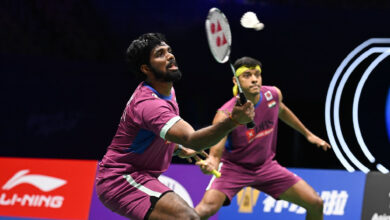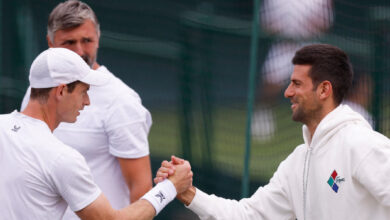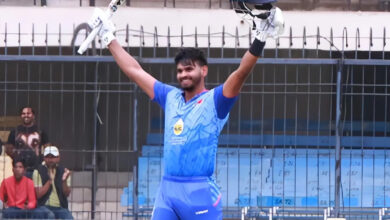Amidst chaos, ‘Brazilian Pep Guardiola’ Fernando Diniz sparkles hopes of a revolution with Selecao | Football News

Fernando Diniz, the interim Brazilian coach, gets emotional when he talks about 1982. It’s the year he lost his father; it was also the year he fell in love with football. “It helped us (he and his brothers) forget the pain,” he would say in an interview with Globo.The ebullience of what the world calls the greatest team to have never won a World Cup would leave a lasting impression on young Diniz. “Although they didn’t win, they captivated many hearts and I was one of them.”
Young Fernando and his brothers would paint the streets in canary yellow. drew the players on the walls, and tuned into every game on the radio. “The team awakened almost a certainty that they would win the title, so there was a lot of crying when they lost. But life is more art than science. Football has the power to move people and change lives,” he would say.
All he dreamt was to wear the Canary Yellow robes. He never realized his dream, the midfielder’s career was spent shuttling through 14 different clubs. So seemed his managerial journey, until he guided Fluminense to the league title before wrapping the season winning the Copa Libertadores the season past. But it was not so much of his success as his playing that fetched him the manager job with the national team.
It could be that he is just an interim coach before Carlo Ancelotti takes over after his contract with Real Madrid expires. It could be that he could be axed if Brazil continues their losing streak (they have lost three on the spin, all to bitter rivals Argentina, Colombia and Uruguay), but Diniz, unfazed the mounting challenges and criticisms, is on a single-minded mission to bring ‘joy back to the way we play.’
“You are the heroes of many people, the face of a country. So you have to play with soul and spirit,” he would say before the World Cup qualifying game against Peru.
But revolutions don’t breed changes overnight. In the six games he had overseen, Brazil thrilled in bursts, won only two and had looked chaotic at times. He does not believe in positional discipline — he is a self-described advocate of apositional play — rather invests heavily in moments of individual dazzle. Watching his teams look a bit anarchic, players abandon their positions, the space they leave behind is often unfilled, they all converge around the ball, most are within shirt-hugging dance with each other, making quick one-two passes between them. The progression involves a lot of back-heels and nutmegs, dribbles and feints and other such cheeky arts. At its best, it is a visual treat, but at its worst, it could look self-indulgent.
An admirer of Pep Guardiola — he is called the Brazilian Guardiola — possession is central to his philosophy. But unlike Guardiola, there is less fixation with structure and space. The formation on paper could be 4-2-3-1 on the team sheet but could quickly morph into 4-2-4 or even 4-1-5. His teams build out from the back, in a cluster, in a narrow width-less formation, circulating the ball with short passes, progressing through the zones. The central idea is that the player on the ball always has three or four passing options close , to create numerical superiority in a particular position.
Passing is short and direct, but the tempo is high. The chief aim is not to create space but enhance passing options. In progression, they strive for the rondo-like whirl of one-touch passes. “The way Pep likes having possession is the opposite of mine. His style is positional, mine is anti-positional,” he had once said.
Diniz does not believe in giving his players specific positions or roles, but in allowing them to interchange at will, to respond to the demands of the game on the go. Controlling zones is not an obsession, the only zone that matters to him is the one near the ball.
The soul of his game, he once asserted, is “player relationships” in that how players read and relate to each other, how they conjure a move spontaneously, a sequence that they had not discussed in the board room. “It’s about giving the players the ultimate freedom to unleash their creativity,” he explained to Globo.
Combination-play is fundamental to his game. It’s what makes his teams look fluent and languid; it is also what makes his team look disjointed because the success of the combination play depends on familiarity and effective combination, which could happen only if they practice together day in and day out. International teams could rarely manage these, and hence the notes that jarred in the qualification games.
A graduate in psychology, he likes to engage his players in long conversations off the field. “He is very clever. He has a particular way of managing and motivating players. It is very interesting,” Bruno Pivetti, a former assant of his, would say.
Diniz’s unorthodox methods have sparked debates in Europe about football’s fixation with structure and position, the essence of the sport in Europe. Some consider his radical approach as the way football would be played in the coming days; some condemn it as foolish and idealic.
And there would be no better advertisement of the formula than winning trophies with Brazil. His ambition, he says, is for his team to play like Santana’s 1982 and win like the 1970 unbeatables. The start has been catastrophic — and Brazilian football is driven as much the trophies they win as the beauty of their game. But revolutions, as hory teaches, do not bring changes overnight.







